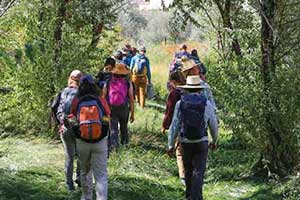Going West

Semester in the West (SITW) resumed in Fall 2021 after a year’s delay due to the pandemic. Led by Miles C. Moore Professor of Politics Phil Brick, the unique program takes a group of Whitman students on a semester-long field program across the American West to learn about public lands conservation and the ecosystems of the region, including its social and political communities.
Here are snapshots of some of the amazing stops and on-site lessons they had along the way.
Dry times. Westies visited the Rio Grande (or Río Bravo, in Mexico) at the western edge of El Paso. The riverbed is dry because the Elephant Butte Dam upstream has cut off all flow to preserve it for U.S. irrigators—water from this river doesn’t reach Mexico until the Río Conchos and springs replenish the flow southeast of El Paso. Students spent the week learning the history and politics of the while practicing creative nonfiction writing with local writer Victoria Blanco, whose family has lived in the region for generations.

Swimming with salmon. Kristen Kirkby ‘04, Semester in the West alum and fisheries biologist with Cascades Fisheries Enhancement Group, gave Westies the chance to swim with fish in the Methow River after a riverside lesson in salmon ecology and stream restoration. Students saw bull trout, mountain whitefish, Chinook salmon and Pacific lamprey juveniles, to name a few.

Wooded bliss. Westies started their ecology segment with botanist and activist Mary O’Brien in southern Utah. The students worked to collect data on the locations of willows, cottonwoods, cattails and Gambel oaks across the area. This data will be used to monitor how the plant communities change as invasive weeds are removed and new plants are put in the ground.

Changing landscape. Westies joined renowned Forest Service landscape ecology researcher Paul Hessburg for a day exploring Black Canyon in the southern Methow Valley. This area burned in 2014 in the Carlton Complex fire and then again in 2015 in the Okanogan Complex Fire, two of the largest fires in Washington state history. Hessburg talked with students about the megafires that have become increasingly more frequent in the American West and how these will change landscapes moving into the future.

Riverside writing. Sophomore Josh Matz writes a report on the riparian health of streams in the Monroe Mountain area of the Fishlake National Forest in Utah. Westies spent the day analyzing data they collected in the field over the previous few days and writing up their findings. Guest educator Mary O’Brien plans to submit these reports to the Forest Service as part of an environmental impact statement related to livestock management in the forest.

Ain’t it grand? The Semester in the West crew stayed at one of Grand Canyon National Park’s classic spots: the Grand Canyon Trust’s Kane Ranch. Students learned about the conservation history of the canyon and its connection to resource extraction on the Navajo Nation.

Canoe for two. In Boquillas Canyon on the Rio Grande, Westies took a multiday canoe trip, where they moved back and forth imperceptibly between Big Bend National Park, Texas, on river left and Coahuila, Mexico, on river right. Unlike many sections of the border, this area is so remote there is no border wall, fence or even markings.

On the wall. Westies spent a few days with guest educators: artist and archaeology expert Joe Pachak and poet Ann Walka. Hikes to view incredible rock art panels and hours spent writing and contemplating made the days at Comb Ridge in southeastern Utah a special time.

Cabbage crew . In late August, the cook crew celebrated International Day of the Cabbage, a holiday coined by field manager Whitney Rich ’20 to honor the vegetable she says comprises one of “the four major food groups on the road.” Want a taste of Semester in the West? Try some of the program’s classic recipes.

Travel deeper with SITW. Read the Westies’ epiphanies, listen to their podcast and meet guest presenters at semesterinthewest.org.